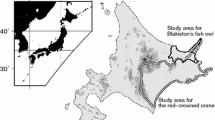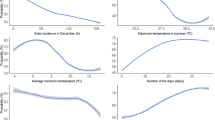Abstract
Biodiversity positively relates with the provisioning of ecosystem services and preserving areas with elevated diversity of highly-functional species could help to ensure human well-being. Most studies addressed to make these decisions use maps relying on species occurrences, where sites containing several species are proposed as priority conservation areas. These maps, however, may underestimate species richness because of the incompleteness of occurrence data. To improve this methodology, we propose using habitat suitability models to estimate the potential distribution of species from occurrence data, and later shaping richness maps by overlapping these predicted distribution ranges. We tested this proposal with Mexican oaks because they provide several ecosystem services and habitat suitability models of species were calibrated with MaxEnt. We used linear regressions to compare the outputs of these predictive maps with those of maps based on species occurrences only and, for both mapping methods, we assessed how much surface of sites with elevated richness and endemism of oaks is currently included within nature reserves. Both mapping methods indicated that oak species are concentrated in mountain regions of Mexico, but predictive maps based on habitat suitability models indicated higher oak richness and endemism that maps based on species occurrences only. Our results also indicated that nature reserves cover a small fraction of areas harboring elevated richness and endemism of oaks. These results suggest that estimating richness across extensive geographic regions using habitat suitability models quickly provides accurate information to make conservation decisions for highly-functional species groups.


Similar content being viewed by others
References
Arriola-Padilla VJ, Estrada-Martínez E, Ortega-Rubio A, Pérez-Miranda R, Gijón-Hernández AR (2014) Deterioro en áreas naturales protegidas del centro de México y del Eje Neovolcánico Transversal. Investigación y Ciencia 22:37–49
Beaumont LJ, Hughes L, Poulsen M (2005) Predicting species distributions: use of climatic parameters in BIOCLIM and its impact on predictions of species’ current and future distributions. Ecol Model 186:251–270. https://doi.org/10.1016/j.ecolmodel.2005.01.030
Caley MJ, Fisher R, Mengersen K (2014) Global species richness estimates have not converged. Trends Ecol Evol 29:187–188. https://doi.org/10.1016/j.tree.2014.02.002
Cardinale BJ, Duffy JE, Gonzalez A et al (2012) Biodiversity loss and its impact on humanity. Nature 486:59–67. https://doi.org/10.1038/nature11148
Cruz-Cárdenas G, López-Mata L, Villaseñor JL, Ortiz E (2014) Potential species distribution modeling and the use of principal component analysis as predictor variables. Rev Mex Biodivers 85:189–199. https://doi.org/10.7550/rmb.36723
De Vos JM, Joppa LN, Gittleman JL, Stephens PR, Pimm SL (2015) Estimating the normal background rate of species extinction. Conserv Biol 29:452–462. https://doi.org/10.1111/cobi.12380
Díaz S, Fargione J, Chapin FS, Tilman D (2006) Biodiversity loss threatens human well-being. PLoS Biol 4:e277. https://doi.org/10.1371/journal.pbio.0040277
Elith J, Graham CH, Anderson RP et al (2006) Novel methods improve prediction of species’ distributions from occurrence data. Ecography 29:129–151. https://doi.org/10.1111/j.2006.0906-7590.04596.x
Elith J, Phillips SJ, Hastie T, Dudík M, Chee YE, Yates CJ (2011) A statistical explanation of MaxEnt for ecologists. Divers Distrib 17:43–57. https://doi.org/10.1111/j.1472-4642.2010.00725.x
Fick SE, Hijmans RJ (2017) WorldClim 2: new 1-km spatial resolution climate surfaces for global land areas. Int J Climatol 37:4302–4315. https://doi.org/10.1002/joc.5086
Fielding AH, Bell JF (1997) A review of methods for the assessment of prediction errors in conservation presence/absence models. Environ Conserv 24:38–49. https://doi.org/10.1017/S0376892997000088
García-Coll I, Matínez AA, Ramírez A, Niño-Cruz A, Rivas AJ, Domínguez L (2004) La relación agua-bosque: delimitación de zonas prioritarias para pago de servicios ambientales hidrológicos en la cuenca del río Gavilanes, Coatepec, Veracruz. In: Cotler H (ed) El manejo integral de cuencas en México: estudios y reflexiones para orientar la política ambiental. Secretaría de Medio Ambiente y Recursos Naturales, Mexico City, pp 99–114
Hipp AL, Manos PS, González-Rodríguez A, Hahn M, Kaproth M, McVay JD, Valencia-Avalos S, Cavender-Bares J (2017) Sympatric parallel diversification of major oak clades in the Americas and the origins of Mexican species diversity. New Phytol 217:439–452. https://doi.org/10.1111/nph.14773
Hirzel AH, Le Lay G (2008) Habitat suitability modelling and niche theory. J Appl Ecol 45:1372–1381. https://doi.org/10.1111/j.1365-2664.2008.01524.x
Hortal J, Lobo JM, Jiménez-Valverde A (2007) Limitations of biodiversity databases: case study on seed-plant diversity in Tenerife, Canary Islands. Conserv Biol 21:853–863. https://doi.org/10.1111/j.1523-1739.2007.00686.x
Hurlbert AH, Jetz W (2007) Species richness, hotspots, and the scale dependence of range maps in ecology and conservation. Proc Natl Acad Sci USA 104:13384–13389. https://doi.org/10.1073/pnas.0704469104
Hurlbert AH, White EP (2005) Disparity between range map- and survey-based analyses of species richness: patterns, processes and implications. Ecol Let 8:319–327. https://doi.org/10.1111/j.1461-0248.2005.00726.x
Jenkins CN, Van Houtan KS, Pimm SL, Sexton JO (2015) US protected lands mismatch biodiversity priorities. Proc Natl Acad Sci USA 112:5081–5086. https://doi.org/10.1073/pnas.1418034112
Kerr JT (1997) Species richness, endemism, and the choice of areas for conservation. Conserv Biol 11:1094–1100. https://doi.org/10.1046/j.1523-1739.1997.96089.x
Koleff P, Tambutti M, March IJ et al (2009) Identificación de prioridades y análisis de vacíos y omisiones de conservación de la biodiversidad de México. In: Sarukhán J, Dirzo R, González R, March IJ (eds) Capital natural de México, vol II. Estado de conservación y tendencias de cambio. Comisión Nacional para el Conocimiento y Uso de la Biodiversidad, Mexico City, pp 651–718
Losos JB (2008) Phylogenetic niche conservatism, phylogenetic signal and the relationship between phylogenetic relatedness and ecological similarity among species. Ecol Let 11:995–1003. https://doi.org/10.1111/j.1461-0248.2008.01229.x
Luna-José AL, Montalvo-Espinosa L, Rendón-Aguilar B (2003) Los usos no leñosos de los encinos en México. Bol Soc Bot Méx 72:107–117
Mace GM, Norris K, Fitter AH (2012) Biodiversity and ecosystem services: a multilayered relationship. Trends Ecol Evol 27:9–26. https://doi.org/10.1016/j.tree.2011.08.006
Martínez M (1981) Los encinos de México. Comisión Forestal del Estado de Michoacán, Morelia
Martínez-Pastur G, Peri PL, Soler RM, Schindler S, Lencinas MV (2016) Biodiversity potential of Nothofagus forests in Tierra del Fuego (Argentina): tool proposal for regional conservation planning. Biodivers Conserv 25:1843–1862. https://doi.org/10.1007/s10531-016-1162-2
Miguel-Talonia C, Téllez-Valdés O, Murguía-Romero M (2014) Las cactáceas del Valle de Tehuacán-Cuicatlán, México: estimación de la calidad del muestreo. Rev Mex Biodivers 85:436–444. https://doi.org/10.7550/rmb.31390
Mokany K, Westcott DA, Prasad S, Ford AJ, Metcalfe DJ (2014) Identifying priority areas for conservation and management in diverse tropical forests. PLoS ONE 9:e89084. https://doi.org/10.1371/journal.pone.0089084
Muñoz-Piña C, Guevara A, Torres JM, Braña J (2008) Paying for the hydrological services of Mexico’s forests: analysis, negotiations and results. Ecol Econ 65:725–736. https://doi.org/10.1016/j.ecolecon.2007.07.031
Nixon KC (2006) Global and neotropical distribution and diversity of oak (genus Quercus) and oak forests. In: Kappelle M (ed) Ecology and conservation of neotropical montane oak forests. Springer, Berlin, pp 3–13
NOM-059-SEMARNAT (2010) Norma Oficial Mexicana-Protección Ambiental-Especies nativas de México de flora y fauna silvestres-Categorías de riesgo y especificaciones para su inclusión, exclusión o cambio-Lista de especies en riesgo. Diario Oficial de la Federación, Mexico City
Orme CDL, Davies RG, Burgess M et al (2005) Global hotspots of species richness are not congruent with endemism or threat. Nature 436:1016–1019. https://doi.org/10.1038/nature03850
Peterson AT, Navarro-Sigüenza AG (1999) Alternate species concepts as bases for determining priority conservation areas. Conserv Biol 13:427–431. https://doi.org/10.1046/j.1523-1739.1999.013002427.x
Peterson AT, Egbert SL, Sánchez-Cordero V, Price KP (2000) Geographic analysis of conservation priority: endemic birds and mammals in Veracruz, Mexico. Biol Conserv 93:85–94. https://doi.org/10.1016/S0006-3207(99)00074-9
Phillips SJ, Anderson RP, Schapire RE (2006) Maximum entropy modeling of species geographic distributions. Ecol Model 190:231–259. https://doi.org/10.1016/j.ecolmodel.2005.03.026
Ramírez-Albores JE, Bustamante RO, Badano EI (2016) Improved predictions of the geographic distribution of invasive plants using climatic niche models. PLoS ONE 11:e0156029. https://doi.org/10.1371/journal.pone.0156029
Ramos-Palacios CR, Badano EI, Flores J, Flores-Cano JA, Flores-Flores JL (2014) Distribution patterns of acorns after primary dispersion in a fragmented oak forest and their consequences on predators and dispersers. Eur J For Res 133:391–404. https://doi.org/10.1007/s10342-013-0771-5
Ricker M, Ramírez-Krauss I, Ibarra-Manríquez G, Martínez E, Ramos CH, González-Medellín G, Gómez-Rodríguez G, Palacio-Prieto JL, Hernández HM (2007) Optimizing conservation of forest diversity: a country-wide approach in Mexico. Biodivers Conserv 16:1927–1957. https://doi.org/10.1007/978-1-4020-6444-9_23
Romero-Rangel S, Rojas-Zenteno EC, Rubio-Licona LE (2015) Encinos de México. Universidad Nacional Autónoma de México, Tlalnepantla
Rosete-Vergés FA, Pérez-Damián JL, Villalobos-Delgado M, Navarro-Salas EN, Salinas-Chávez E, Remond-Noa R (2014) El avance de la deforestación en México 1976–2007. Madera y Bosques 20:21–35
Rzedowski J (1978) Vegetación de México, 2nd edn. Editorial Limusa, Mexico City
Sax DF, Early R, Bellemare J (2013) Niche syndromes, species extinction risks, and management under climate change. Trends Ecol Evol 28:517–523. https://doi.org/10.1016/j.tree.2013.05.010
Steele MA, Smallwood PD (2002) Acorn dispersal by birds and mammals. In: McShea WJ, Healy WM (eds) Oak forest ecosystems: ecology and management for wildlife. Johns Hopkins University Press, Baltimore, pp 182–195
Toledo VM (2005) Repensar la conservación: ¿Áreas naturales protegidas o estrategia bioregional? Gac Ecol 77:67–83
Torres-Miranda A, Luna-Vega I, Oyama K (2011) Conservation biogeography of red oaks (Quercus, Section Lobatae) in Mexico and Central America. Am J Bot 98:290–305. https://doi.org/10.3732/ajb.1000218
Valencia S (2004) Diversidad del genero Quercus (Fagaceae) en México. Bol Soc Bot Méx 75:33–53
Warren DL, Glor RE, Turelli M (2008) Environmental niche equivalency versus conservatism: quantitative approaches to niche evolution. Evolution 62:2868–2883. https://doi.org/10.1111/j.1558-5646.2008.00482.x
Wisz MS, Hijmans RJ, Li J, Peterson AT, Graham CH, Guisan A (2008) Effects of sample size on the performance of species distribution models. Divers Distrib 14(763):773. https://doi.org/10.1111/j.1472-4642.2008.00482.x
Zavala-Chávez F (1989) Identificación de encinos de méxico. Universidad Autónoma Chapingo, Texcoco
Acknowledgements
We thank the assistance of Juan Pablo Rodas-Ortiz during the compilation of oak occurrence data. This work was supported by Consejo Nacional de Ciencia y Tecnología de México (Grant CB-2013/221623 to EIB).
Author information
Authors and Affiliations
Corresponding author
Additional information
Communicated by David Hawksworth.
This article belongs to the Topical Collection: Biodiversity protection and reserves.
Electronic supplementary material
Below is the link to the electronic supplementary material.
10531_2018_1596_MOESM1_ESM.docx
Supplementary material of this study is freely available at the Zenodo repository under the following doi: http://doi.org/10.5281/zenodo.1133339. These materials include a Microsoft Excel file (SM 01-Oak occurrences.xlsx) that contains the occurrence points used to calibrate the habitat suitability models of the 59 oak species. The repository also contains interactive maps indicating the predicted and observed distributions of the 59 Mexican oak species (SM 02-Estimated oak distribution ranges.kmz), as well as the probability-based and occurrence-based maps of oak richness and endemism (SM 03-Oak richness maps.kmz). These maps projections are provided in KMZ format to make them easy to visualize in Google Earth (freely available at www.google.com/earth). Supplementary material 1 (DOCX 13 kb)
Rights and permissions
About this article
Cite this article
Hernández-Quiroz, N.S., Badano, E.I., Barragán-Torres, F. et al. Habitat suitability models to make conservation decisions based on areas of high species richness and endemism. Biodivers Conserv 27, 3185–3200 (2018). https://doi.org/10.1007/s10531-018-1596-9
Received:
Revised:
Accepted:
Published:
Issue Date:
DOI: https://doi.org/10.1007/s10531-018-1596-9




